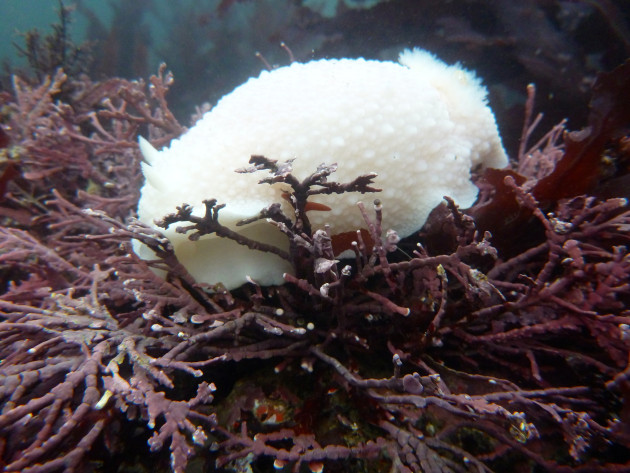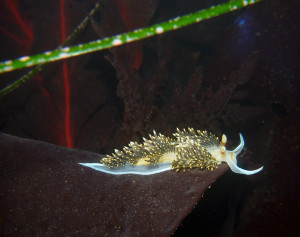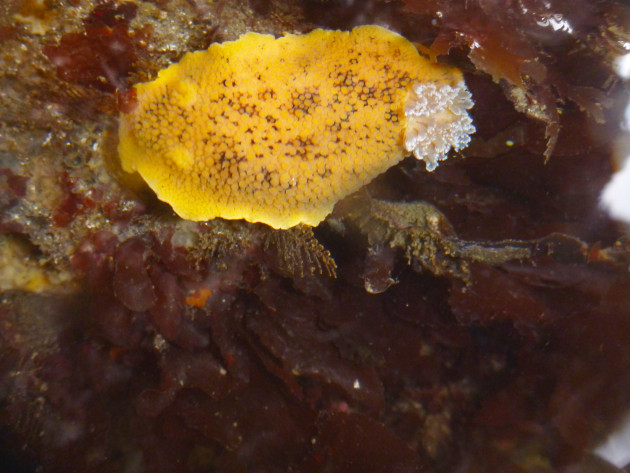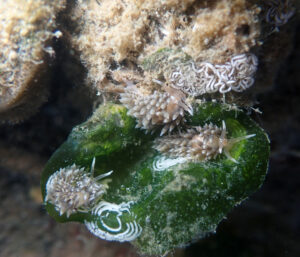n the basement of the California Academy of Sciences, in a mostly brown room where eight researchers have gathered to discuss the world’s most colorful invertebrate, hangs a large tapestry of Elvis Presley. Microphone to mouth, collar to chin and hair slicked in a gently rising wave, he is posed against a blue backdrop splashed with bright yellow stars. Elvis – well, this one — belongs to the collections manager of the Academy’s geology department, a particularly die-hard fan whose Presley paraphernalia is well known in the basement. Here, among eight invertebrate researchers and a musty library, Elvis is the loudest thing in the room — and it becomes impossible not to draw some parallel between The King and the tiny, anonymous pauper of marine biology that utterly commands the attention of the scientists assembled here. Elvis, you could say, has always been the nudibranch in the tidepool.

he nudibranch is a widely distributed shell-less marine slug, roaringly popular with photographers, which has only just begun to be deeply researched. The scientists in the Academy’s library are graduate students, participating in a weekly class known as ”slug lab.“ Under the supervision of Terry Gosliner, the Academy’s dean of science and research collections, the students discuss new literature and dissertation topics, and at times, diverge into long tales of close encounters with sea hares. The lab comprises a relatively young group whose interests range from conservation to evolution, with one common factor: unbridled enthusiasm for “nudis’.”
Victoria Kentner, a master’s student at San Francisco State University, is leaning against a wall-length bookshelf of dictionaries, encyclopedias and Atlases, some in other languages, others whose cloth spines are dangling by a few threads. She is in the final stage of writing a thesis comparing nudibranch diversity in protected areas versus non-protected areas. Beside her sits Alexandra Lee, a graduate student from Nova Southeastern University in Florida, who asks the class to brainstorm approaches to her thesis topic. Exasperated, she asks for contacts, papers, ideas, anything that might aid her research on nudibranch chemical defenses and the evolutionary process. At the other end of the table sits Joshua Hallas, another SFSU graduate student. Hallas is using phylogenetics to create a sort of nudibranch family tree of the Onchidorididae family — something that does not yet exist.
Gosliner, sitting at the head of the table, says that worldwide there are anywhere from 40 to 50 scientists undertaking serious research on nudibranchs. Gosliner himself is among the world’s foremost nudibranch authorities, having discovered more than 1,000 new species. But nudibranchs are unusual: their popularity among the general public far outweighs their popularity among scientists. Compare these near 50 scientists to the thousands of underwater photographers and tidepool enthusiasts whose nudibranch images are the subject of Flickr feeds, Tumblrs, and dedicated websites.
And that, right there, is pretty much the state of nudibranch research.

here are lots of pretty pictures of the 3,000 nudibranchs species already discovered, but few specifics. Key elements of their fundamental biology are still poorly understood, or not understood at all. Or not even examined. “There’s still just so much that we are learning about,” Gosliner says. “Not only what species are out there but then more significantly, aspects of their biology and their use in conservation.”
While nudibranchs feature in Ed Ricketts’ seminal 1939 book, Between Pacific Tides, nudibranch research really only started in the 1960s. Kentner says that she has come across several scientific papers written in the early ‘70s that are basically just species lists compiled in San Mateo County.
“Now, if you want to publish something in science,” she says, “it actually has to say something.”
That’s always been the difficulty with nudibranchs. Gosliner once took this to its logical extreme, publishing a paper in the 1990s with the particularly philosophical sub-title, “How do we know what we don’t know?”
Lee chimes in to recall a paper she saw recently that questioned whether a species really exists, proposing instead that the term “species” is just a construction. “After that,” she says. “I thought, ‘That’s it, I don’t even care.’”
“They can tell each other apart just fine,” Gosliner replies. “We’re the problem.”

udibranchs — meaning “naked gills” in Latin — are soft-bodied gastropods, in the same phylum as mollusks, that have evolved to shed their shell shortly after a larval stage. Their bright colors, feathery gills and alien-like horns make them one of the most photogenic marine species, but most photographs of nudibranchs are in fact, lying to you. The majority of nudibranchs are not the size of your forearm, as a macro lens may make them appear, but are an average of two inches long, with the smallest growing to just a quarter of an inch.
Although Kentner’s dissertation focuses on a specific aspect of nudibranchia, she has an elementary “What are nudibranchs?” presentation on hand. (She has noticed, that when you bring up nudibranchs outside of the slug lab, “What is their diversity in marine protected areas” is not typically the first question you get.)
So, she starts at the beginning: There are two nudibranch classifications, she says, forwarding the slides to a black-and-white sketched diagram. Dorids are generally large, round and flat, while aeolids are smaller and characterized by lush, feathery gills called ”cerata,” in which they store part of their digestive system. Cerata are the most attractive nudibranch feature, but as they say, looks can be deceiving. Both dorids and aeolids are able to use their cerata as a defense mechanism.
Aeolid species such as the opalescent sea slug, Hermissenda crassicornis, store and re-appropriate the stinging cells from their prey to then use against predators. The dorid sea lemon, Peltadoris nobilis, meanwhile, feeds on sea sponges then uses its prey’s toxins to make itself taste sour or smell particularly bad. As the name suggests, when handled the Peltadoris nobilis smells like lemons.
“It’s one of the coolest things about them,” Kentner says. “The more I learn about sea slugs, the more I’m like, ‘Are you kidding me?’”
Originally from a landlocked town in Pennsylvania, Kentner got scuba certified in a quarry where a glimpse of a fish was especially exciting. She says she’s always been interested in two things: conservation and “cute little wet things.” As an undergraduate she researched a threatened species of turtle in Pennsylvania and was considering studying amphibians, perhaps salamanders, when she moved to the Bay Area for graduate school.
That was two years ago, and marked the beginning of Kentner’s nudibranch education. On her first trip to Fitzgerald Marine Reserve, as she teetered on the edge of the continent peering into a rocky tidepool, she says she felt as though she was looking into a “secret world.”
hat world contains multitudes, as the poet Whitman said. The tides ripple across the surface of the water, sea stars grip the rocky walls and the nudibranchs, because of their size or the sheer busyness of the pools, hide rather modestly amongst the quiet chaos of the intertidal.
But there is a big difference between glimpsing a secret world and purposefully identifying nudibranchs for a dissertation. So Kentner, intertidal guide book on hand, went to the San Francisco marina docks in search of nudibranchs. And there, gripping the substrates and lining the thick ropes that dangle off the edge of the piers, were several San Diego dorids. They are round, flat and as Kentner describes them, kind of like “little mice” with rhinophores standing in place of perky ears.
Since then, she has been to nearly every extreme low tide at Pillar Point, Fitzgerald Marine Reserve, Duxbury Reef and Palomarin, searching, counting, measuring and documenting nudibranch diversity. She estimates that there are around 100 species of nudibranch — the “gems of the tidepool” as she calls them — in the California intertidal zone and since that first trip she has documented around 40 species, earning her a reputation among her classmates as the ”person best able to spot the tiniest of nudibranchs.” Kentner laughs at the title, and attributes her success to the windy afternoons and very early mornings spent trawling the tidepools for crevices and food sources that might suggest something more hiding in the water.
“I get a kind of spider sense,” she says. “And if you think there’s something there, you just wait.”
Seated at a desk in the California Academy of Sciences, she opens a document with a series of graphs and charts, one pasted below another — the product of her data analysis so far. Kentner hypothesized that marine protected areas such as Fitzgerald would host more species, greater diversity and larger nudibranch size. She is still in the process of sorting through the data but so far, she says, it seems there is no difference in diversity — although the total number of species is higher at protected sites.
She is also comparing her study with historical data collected by Gosliner in the late 1960s and onwards. Overall she has seen fewer rare species when compared to earlier surveys, but the presence of one species more normally found in the south has continued to increase since the 1980s. Opening a gridded spreadsheet that shows the frequency of sightings per species, Kentner points to the line reading: Phidiana hiltoni.

P. hiltoni, nicknamed the “killer seaslug” because of a tendency to eat other nudibranchs, is an aeolid that grows to nearly three inches long and looks like a small shag pile rug. Typically, the species was found south of Monterey, but by 1992 it had expanded its range north to Duxbury Reef where it is now one of the most abundant species. Scientists believe P. hiltoni creeped its way north during El Niño events and has since been able to persist along the northern coast.
Kentner continues scrolling to a cluster chart showing a “Jaccard index of similarity”: using current and historical data — compiled in the late 1960s and early 1970s — the graph shows how similar sites are, based on the species that inhabit them. In the 1970s, Duxbury Reef and Palomarin were clustered together, and still are today, which Kentner says can be expected because of their proximity. The same goes for Fitzgerald Marine Reserve and Pillar Point in the 1970s. But interestingly, Fitzgerald Marine Reserve today is clustered closer to the historical data than Pillar Point, suggesting that its status as a marine protected area has contributed to the species found at the site.
One last graph compares the species and individuals seen at different tide heights. The number of species remains more or less the same, but the number of individuals seen rises as the tide goes out. The idea, Kentner says, is that as the water gets lower the nudibranchs congregate in deeper pools, with the benefit being less exposure to the elements. But for Kentner this graph raises a long list of questions: what’s happening when nudibranchs are not squashed into tidepools? What are they doing at night? What does the tidepool itself look like at high tide?
“We only see this one little speck of their lives, when we’re scuba diving or when there’s a low tide for an hour out of the month,” she says. “What are they doing the rest of the time?”

eside Kentner’s desk is a trolley loaded with nudibranch specimens that were at some point popped in a jar and preserved with ethanol. Nudibranchs are difficult to breed and even more difficult to keep in captivity, meaning they are seldom seen alive outside of their habitat. Hallas, who has been typing a few desks away, often works with specimens and obligingly pulls an interesting jar from the cupboard. It is a specimen of Hexabranchus sanguineus, or the Spanish dancer. When alive, this dorid is a bright red with a billowing fringe called a parapodia that looks like the trimming on a flamenco dancer’s skirt. Preserved, nudibranchs lose their color and the Spanish dancer becomes a cream colored pickle suspended in a watery brine.
As Ricketts wrote in Between Pacific Tides, “a colorless, collapsed nudibranch is certainly not an inspiring object.” But as Hallas suggests, most scientists do not study them for their pretty hues. For many like Hallas, it is the unanswered questions — the “possible PhDs,” Gosliner calls them — that make even the blandest of nudibranch specimens inspiring.
ack in the slug lab, under the watchful eyes of Elvis Presley, Lee reiterates her plea for research suggestions. There is mostly silence. Hallas pipes up to say he once considered a similar project until he realized it was a “pain in the ass.”
“That’s one explanation for the scarcity of information,” Gosliner says.
Studying nudibranchs, it turns out, is a lot like finding them. Difficult at times, endlessly interesting and certainly satisfying when what you are looking for manifests itself — in the form of a journal paper or in a small blob of color at the bottom of a tidepool. But pain in the ass or not, nudibranch research is essentially an optimistic science. And this stands true for a lot of invertebrate research: the mysteries are greater than the answers and each answer only raises more questions.
The conversation moves on, to scuba diving with dugongs, water visibility in Monterey, and an upcoming Philippines expedition Gosliner will make in mid-April. But on a large, gray filing cabinet to the left of that tapestry there is a hint of color. It is coming from two small magnets of Elvis Presley in brightly colored, highly embellished and borderline ridiculous jumpsuits. They are slight in comparison to the size of the space but like a nudibranch, they’ve got presence.
Partly, it’s sheer spectacle: the colors, the sequins and the costumes made Elvis a cultural icon of the 20th century and have allowed nudibranchs to dominate the world of underwater photography. But behind that flamboyant facade there is just a person, a Spanish dancer specimen that has lost its billowing frills. And for their respective fans, the die-hard Presley collector or the slug lab of graduate students, that is what is most interesting. Whether the nudibranch is in the tidepool or preserved in a jar of brine, whether with color or without, it is still the king.





